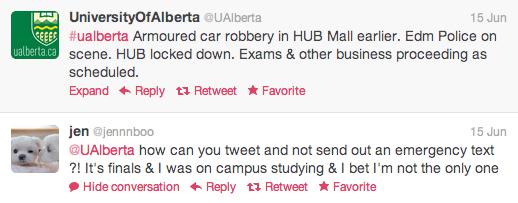
The University of Alberta is facing criticism for not using their emergency notification system (ENS) to notify staff and students immediately following fatal shootings on campus June 15.
Social media was abuzz with complaints from students and staff who felt the school should have used the system.
“@UAlberta Surprised that as #ualberta staff I did not receive something through the emergency notification system…?” @KristanMorin tweeted.
“@UAlberta if this doesn’t constitute an emergency fit for a notification, I don’t know what does,” tweeted @fvaughanj (Fay Vaughan-Johnston).
University of Alberta officials did post regular updates on the school website and Twitter, but chose not to use the school’s emergency notification system.
That decision was based on information from Edmonton police that the shooter was no longer on the campus and therefore did not pose a threat to staff and students, according to a message by U of A acting president Carl Amrhein on the school’s website.
The way the ENS system was used in the shooting will be part of an “incident debrief” by the school, Amrhein wrote.
Some were upset that the school chose to use Twitter instead of the ENS.
“@UAlberta how can you tweet and not send out an emergency text ?! It’s finals & I was on campus studying & I bet I’m not the only one,” tweeted @jennnboo.
“#ualberta didn’t want to alarm 50,000 students”, sorry #ualberta, but social media gen knows before you do. alerts should be sooner. #yeg,” tweeted @jole (Joel Adria).
In case of a crisis similar to the one at U of A, Carleton’s department of safety would likely activate its own ENS, said director of university safety Allan Burns.
However, Burns pointed out that the ENS’ purpose is to instruct people on things they have to do in an emergency.
“It’s not a system we use to inform people about what’s happening unless it directly involves them. We would use the internal Carleton communication system to keep people updated in terms of what’s happening,” Burns said.
Only about 3,500 staff and students have signed up for Carleton’s ENS, Burns said.
There are nearly 27,000 full and part-time students at Carleton, and roughly 2,600 staff, according to the Carleton website, which means only one in eight people would be warned of a crisis on campus through the EMS, something Burns identified as a weakness.
“One of the problems is trying to convince students to sign up for it,” he said, pointing out that the system is voluntary.
Carleton’s ENS includes a text message component, Burns said, as well as emails sent to anyone with a Carleton account and a “screen capture” pop-up on computers registered with the school.
Students can sign up for the ENS through Carleton Central.



